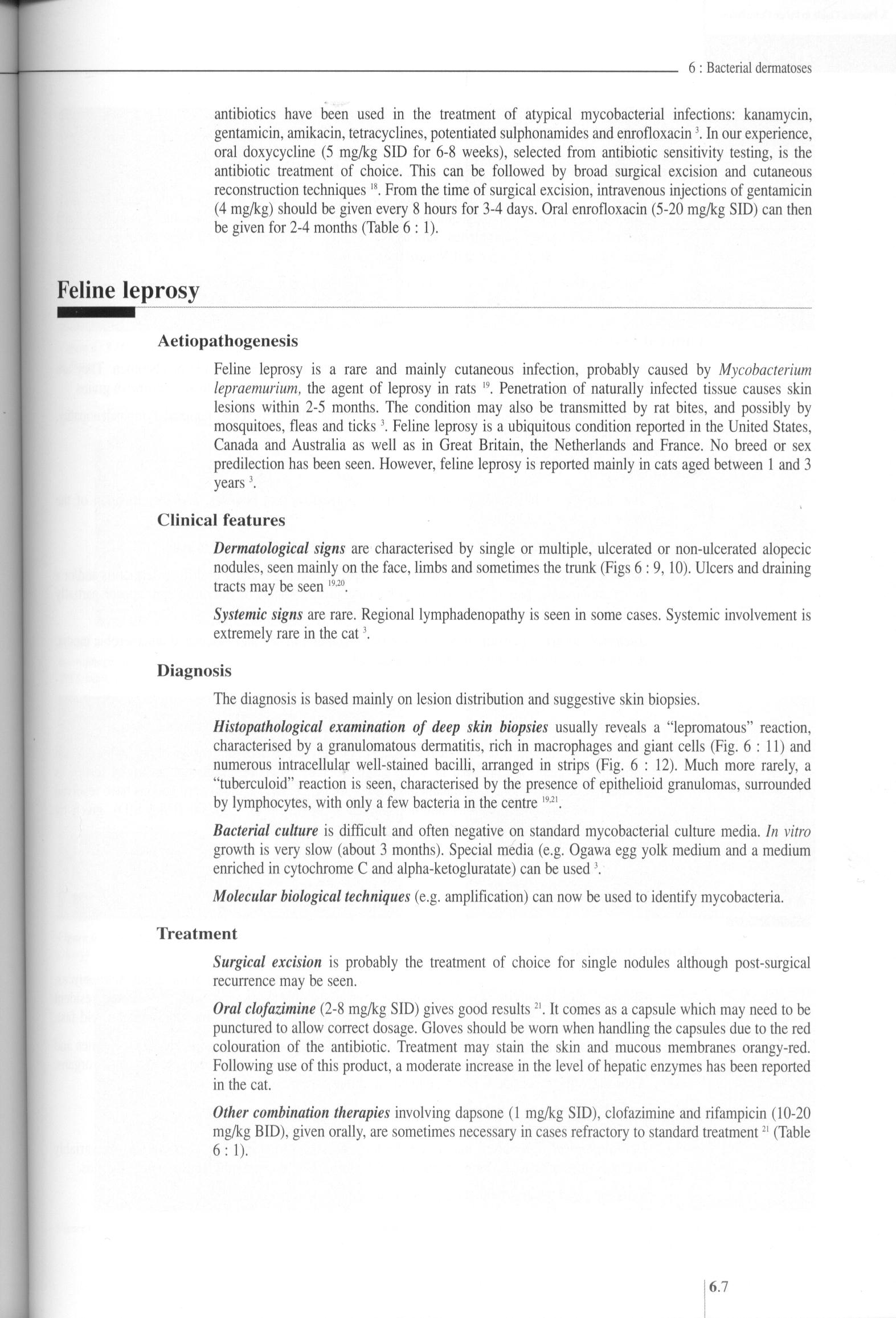66 (126)

6: Bacterial dermatoses
antibiotics have been used in the treatment of atypical mycobacterial infections: kanamycin, gentamicin, amikacin, tetracyclines, potentiated sulphonamides and enrofloxacin3. In our experience, orał doxycycline (5 mg/kg SID for 6-8 weeks), selected from antibiotic sensitivity testing, is the antibiotic treatment of choice. This can be followed by broad surgical excision and cutaneous reconstruction techniąuesl8. From the time of surgical excision, intravenous injections of gentamicin (4 mg/kg) should be given every 8 hours for 3-4 days. Orał enrofloxacin (5-20 mg/kg SID) can then be given for 2-4 months (Table 6:1).
Feline leprosy
Aetiopathogenesis
Feline leprosy is a rare and mainly cutaneous infection, probably caused by Mycobacterium lepraemurium, the agent of leprosy in rats I9. Penetration of naturally infected tissue causes skin lesions within 2-5 months. The condition may also be transmitted by rat bites, and possibly by mosąuitoes, fleas and ticks 3. Feline leprosy is a ubiąuitous condition reported in the United States, Canada and Australia as well as in Great Britain, the Netherlands and France. No breed or sex predilection has been seen. However, feline leprosy is reported mainly in cats aged between 1 and 3 years3.
Clinical features
Dermatological signs are characterised by single or multiple, ulcerated or non-ulcerated alopecic nodules, seen mainly on the face, limbs and sometimes the trunk (Figs 6 : 9,10). Ulcers and draining tracts may be seen l9,2°.
Systemie signs are rare. Regional lymphadenopathy is seen in some cases. Systemie involvement is extremely rare in the cat3.
Diagnosis
The diagnosis is based mainly on lesion distribution and suggestive skin biopsies.
Histopathological examination of deep skin biopsies usually reveals a “lepromatous” reaction, characterised by a granulomatous dermatitis, rich in macrophages and giant cells (Fig. 6 : 11) and numerous intracelluląr well-stained bacilli, arranged in strips (Fig. 6 : 12). Much morę rarely, a “tuberculoid” reaction is seen, characterised by the presence of epithelioid granulomas, surrounded by lymphocytes, with only a few bacteria in the centre l9-21.
Bacterial culture is difficult and often negative on standard mycobacterial culture media. In vitro growth is very slow (about 3 months). Special media (e.g. Ogawa egg yolk medium and a medium enriched in cytochrome C and alpha-ketogluratate) can be used3.
Molecular biological techniques (e.g. amplification) can now be used to identify mycobacteria. Treatment
Surgical excision is probably the treatment of choice for single nodules although post-surgical recurrence may be seen.
Orał clofazimine (2-8 mg/kg SID) gives good results21. It comes as a capsule which may need to be punctured to allow correct dosage. Gloves should be wom when handling the capsules due to the red colouration of the antibiotic. Treatment may stain the skin and mucous membranes orangy-red. Following use of this product, a moderate inerease in the level of hepatic enzymes has been reported in the cat.
Other combination therapies involving dapsone (1 mg/kg SID), clofazimine and rifampicin (10-20 mg/kg BID), given orally, are sometimes necessary in cases refractory to standard treatment21 (Table 6:1).
6.7
Wyszukiwarka
Podobne podstrony:
49 (197) 4: Dermatophytosis Ketoconazole is a fungicidal azole drug, used in the treatment of dermat
earthquakes have been analyzed (69]; the disperslon of such waves has been used to determłne models&
Dysorvequation method (which 1$ used in quantum field theory) have been analyzed (107). The existenc
S5004023 Coins and power in Lata Iron Age Britain 40 to have been taken over the colour of the early
Ex. 4 1. This chest of drawers is thought to have been madę in the 16lh century. 2
Mr. J. Pokorny. These maps have been constructed by the staff of the Chair of Physical Geography U.
221 (29) Bibliography We have INCLUDED not only the works that we have used in the making of this bo
16 Ludosław Drelichowski The reports which have been presented in the following pages contain the in
AUC generates triplets used in the authentication of SIM card and used in the ciphering of speech, d
DKW GB250 1 DKW has always been ahead in the design of 250 c. c. motorcycles. In 1927 the factory in
DKW GB250 Mini Maximum speed 71 m.p.h. DKW has alwoys been ahead in the design of 250 c. c. motorcyc
METROPOLITAN FORUMNORDA NORDA - is the name used in the offer of the northernmost area of Polan
Dydaktyka 3 It was called Classical Method sińce it was first used in the teaching of the classical
26327 page10 (14) The 1.3 liter Sedan and 4 seater Convertible now have a 3 d defroster vent in the
więcej podobnych podstron